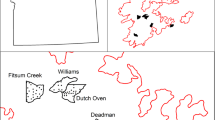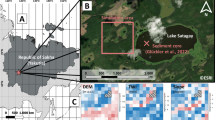Abstract
Natural resource managers are often challenged with balancing requirements to maintain wildlife populations and to reduce risks of catastrophic or dangerous wildfires. This challenge is exemplified in the Sierra Nevada of California, where proposals to thin vegetation to reduce wildfire risks have been highly controversial, in part because vegetation treatments could adversely affect an imperiled population of the fisher (Martes pennanti) located in the southern Sierra Nevada. The fisher is an uncommon forest carnivore associated with the types of dense, structurally complex forests often targeted for fuel reduction treatments. Vegetation thinning and removal of dead-wood structures would reduce fisher habitat value and remove essential habitat elements used by fishers for resting and denning. However, crown-replacing wildfires also threaten the population’s habitat, potentially over much broader areas than the treatments intended to reduce wildfire risks. To investigate the potential relative risks of wildfires and fuels treatments on this isolated fisher population, we coupled three spatial models to simulate the stochastic and interacting effects of wildfires and fuels management on fisher habitat and population size: a spatially dynamic forest succession and disturbance model, a fisher habitat model, and a fisher metapopulation model, which assumed that fisher fecundity and survivorship correlate with habitat quality. We systematically varied fuel treatment rate, treatment intensity, and fire regime, and assessed their relative effects on the modeled fisher population over 60 years. After estimating the number of adult female fishers remaining at the end of each simulation scenario, we compared the immediate negative effects of fuel treatments to the longer-term positive effect of fuel treatment (via reduction of fire hazard) using structural equation modeling. Our simulations suggest that the direct, negative effects of fuel treatments on fisher population size are generally smaller than the indirect, positive effects of fuel treatments, because fuels treatments reduced the probability of large wildfires that can damage and fragment habitat over larger areas. The benefits of fuel treatments varied by elevation and treatment location with the highest net benefits to fisher found at higher elevations and within higher quality fisher habitat. Simulated fire regime also had a large effect with the largest net benefit of fuel treatments occurring when a more severe fire regime was simulated. However, there was large uncertainty in our projections due to stochastic spatial and temporal wildfires dynamic and fisher population dynamics. Our results demonstrate the difficulty of projecting future populations in systems characterized by large, infrequent, stochastic disturbances. Nevertheless, these coupled models offer a useful decision-support system for evaluating the relative effects of alternative management scenarios; and uncertainties can be reduced as additional data accumulate to refine and validate the models.





Similar content being viewed by others
Reference
Agee JK, Skinner CN (2005) Basic principles of forest fuel reduction treatments. For Ecol Manag 211:83–96
Apigian KO, Dahlsten DL, Stephens SL (2006) Fire and fire surrogate treatment effects on leaf litter arthropods in a western Sierra Nevada mixed-conifer forest. For Ecol Manag 221:110–122
Brashares JS (2010) Filtering wildlife. Science 329:402–403
Clark JS, Carpenter SR, Barber M, Collins S, Dobson A, Foley JA, Lodge DM, Pascual M, Pielke RJ, Pizer W, Pringle C, Reid WV, Rose KA, Sala O, Schlesinger WH, Wall DH, Wear D (2001) Ecological forecasts: an emerging imperative. Science 293:657–660
Collins BM, Stephens SL (2007) Managing natural wildfires in Sierra Nevada wilderness areas. Front Ecol Environ 5:523–527
Collins BM, Moghaddas JJ, Stephens SL (2007) Initial changes in forest structure and understory plant communities following fuel reduction activities in a Sierra Nevada mixed conifer forest. For Ecol Manag 239:102–111
Davis F, Seo C, Zielinski WJ (2007) Regional variation in home-range scale habitat models for fisher (Martes pennanti) in California. Ecol Appl 17:2195–2213
Dellasala DA, Williams JE, Williams CD, Franklin JF (2004) Beyond smoke and mirrors: a synthesis of fire policy and science. Conserv Biol 18:976–986
Finney MA, Seli RC, McHugh CW, Ager AA, Bahro B, Agee JK (2006) Simulation of long-term landscape-level fuel treatment effects on large wildfires. In: Proceedings of USDA Forest Service RMRS-P-41, Fort Collins
Grace JB, Pugesek BH (1998) On the use of path analysis and related procedures for the investigation of ecological problems. Am Nat 152:151–159
Higgins SI, Clark JS, Nathan R, Hovestadt T, Schurr F, Fragoso JMV, Aguiar MR (2003) Forecasting plant migration rates: managing uncertainty for risk assessment. J Ecol 91:341–347
Kim Y-H, Bettinger P, Finney M (2009) Spatial optimization of the pattern of fuel management activities and subsequent effects on simulated wildfires. Eur J Oper Res 197:253–265
Lehmkuhl JF, Kennedy M, Ford ED, Singleton PH, Gaines WL, Lind RL (2007) Seeing the forest for the fuel: integrating ecological values and fuels management. For Ecol Manag 246:73–80
Lewis JC, Hayes GE (2004) Feasibility assessment for reintroducing fishers to Washington. Washington Department Fish and Wildlife, Olympia
Lutz JA, van Wagtendonk JW, Thode AE, Miller JD, Franklin JF (2009) Climate, lightning ignitions, and fire severity in Yosemite National Park, California, USA. Int J Wildland Fire 18:765–774
Manley PN (2004) The Future of Biodiversity in the Sierra Nevada through the Lake Tahoe Basin Looking Glass. Gen. Tech. Rep. PSW-GTR-193. USDA Forest Service, Pacific Southwest Research Station. Davis, California
Millar CI, Stephenson NL, Stephens SL (2007) Climate change and forests of the future: managing in the face of uncertainty. Ecol Appl 17:2145–2151
Noss RF, Franklin JF, Baker WL, Schoennagel T, Moyle PB (2006) Managing fire-prone forests in the western United States. Front Ecol Environ 4:481–487
Overpeck J, Udall B (2010) Dry times ahead. Science 328:1642–1643
Powell RA, Zielinski WJ (1994) FisherUSDA Forest Service General Technical Report RM-254. Rocky Mtn. Forest and Range Exp. Station, Fort Collins, CO
Preisler HK, Brillinger DR, Burgan RE, Benoit JW (2004) Probability based models for estimation of wildfire risk. Int J Wildland Fire 13:133–142
Rhodes JJ, Baker WL (2008) Fire probability, fuel treatment effectiveness and ecological tradeoffs in western U.S. public forests. Open For Sci J 1:1–7
Scheller RM, Mladenoff DJ (2004) A forest growth and biomass module for a landscape simulation model, LANDIS: design, validation, and application. Ecol Model 180:211–229
Scheller RM, Domingo JB, Sturtevant BR, Williams JS, Rudy A, Gustafson EJ, Mladenoff DJ (2007) Design, development, and application of LANDIS-II, a spatial landscape simulation model with flexible spatial and temporal resolution. Ecol Model 201:409–419
Schmidt DA, Taylor AH, Skinner CN (2008) The influence of fuels treatment and landscape arrangement on simulated fire behavior, Southern Cascade range, California. For Ecol Manag 255:3170–3184
Schoennagel T, Veblen TT, Romme WH (2004) The interaction of fire, fuels, and climate across Rocky mountain forests. Bioscience 54:661–676
Schumaker NH (1998) A user’s guide to the PATCH model. EPA/600/R-98/135. U.S. Environmental Protection Agency, Environmental Research Laboratory, Corvallis
Scott TA, Wehtje W, Wehtje M (2001) The need for strategic planning in passive restoration of wildlife populations. Restor Ecol 9:262–271
SNEP Science Team and Special Consultants (1996) Summary of the Sierra Nevada Ecosystem Project Report. Centers for Water and Wildland Resources Report No. 39. University of California, Davis
Spencer WD, Rustigian-Romsos H, Strittholt J, Scheller RM, Zielinski W, Truex R (2011) Using occupancy and population models to assess habitat conservation opportunities for an isolated carnivore population. Biol Conserv 144:788–803
Stainforth DA, Aina T, Christensen C, Collins M, Faull N, Frame DJ, Kettleborough JA, Knight S, Martin A, Murphy JM, Piani C, Sexton D, Smith LA, Spicer RA, Thorpe AJ, Allen MR (2005) Uncertainty in predictions of the climate response to rising levels of greenhouse gases. Nature 433:403–406
Stephens SL, Moghaddas JJ (2005a) Experimental fuel treatment impacts on forest structure, potential fire behavior, and predicted tree mortality in a California mixed conifer forest. For Ecol Manag 215:21–36
Stephens SL, Moghaddas JJ (2005b) Silvicultural and reserve impacts on potential fire behavior and forest conservation: twenty-five years of experience from Sierra Nevada mixed conifer forests. Biol Conserv 125:369–379
Sturtevant BR, Scheller RM, Miranda BR, Shinneman D (2009) Simulating dynamic and mixed-severity fire regimes: a process-based fire extension for LANDIS-II. Ecol Model 220:3380–3393
Syphard AD, Scheller RM, Ward BC, Spencer WD, Strittholt JR (2011) Simulating landscape-scale effects of fuels treatments in the Sierra Nevada, California. Int J Fire Manag 20:364–383
Thompson CM, Zielinski WJ, Purcell KL (2011) Evaluating management risks using landscape trajectory analysis: a case study of California fisher. J Wildl Manag 75:1164–1176
Tiedemann AR, Klemmedson JO, Bull EL (2000) Solution of forest health problems with prescribed fire: are forest productivity and wildlife at risk? For Ecol Manag 127:1–18
USDA Forest Service Region 5 (2006) Fisher and marten status and trend monitoring. Forest monitoring summary for October 2, 2004 to September 30, 2005. Prepared for Sierra Nevada Forest Plan Implementation. http://www.fs.fed.us/r5/snfpa/am/monitoringreport2005/fishermarten.html
Westerling AL, Hidalgo HG, Cayan DR, Swetnam TW (2006) Warming and earlier spring increase western US forest wildfire activity. Science 313:940–943
Xu C, Guneralp B, Gertner GZ, Scheller RM (2010) Elasticity and loop analyses: tools for understanding forest landscape response to climate change in spatial dynamic models. Landscape Ecol 25:855–871
Zielinski WJ, Truex RL, Schmidt GA, Schlexer FV, Schmidt KN, Barrett RH (2004) Home range characteristics of fishers in California. J Mammal 85:649–657
Zielinski WJ, Truex RL, Schlexer RV, Campbell LA, Carroll C (2005) Historical and contemporary distributions of carnivores in forest of the Sierra Nevada, California, USA. J Biogeogr 32:1385–1407
Zielinski WJ, Truex RL, Dunk JR, Gaman T (2006) Using forest inventory data to assess fisher resting habitat suitability in California. Ecol Appl 16:1010–1025
Acknowledgments
Funding was provided by Pacific Southwest Region of the USDA Forest Service (Region 5), with guidance and support from Chris Knopp, Diane Macfarlane, Beth Pendleton, and Art Gaffrey. Richard Truex provided the fisher monitoring data and insights about modeling, methods, and fisher biology. Our technical work was reviewed by an experienced group of science advisors including William Zielinski, Frank Davis, Reginald Barrett, Carl Skinner, Scott Stephens, John Vankat, Jan van Wagtendonk, David Graber, Keith Aubry, Bob Heald, Malcolm North, and David Mladenoff. Two anonymous reviewers provided essential feedback and improvements to an earlier version of this manuscript.
Author information
Authors and Affiliations
Corresponding author
Rights and permissions
About this article
Cite this article
Scheller, R.M., Spencer, W.D., Rustigian-Romsos, H. et al. Using stochastic simulation to evaluate competing risks of wildfires and fuels management on an isolated forest carnivore. Landscape Ecol 26, 1491–1504 (2011). https://doi.org/10.1007/s10980-011-9663-6
Received:
Accepted:
Published:
Issue Date:
DOI: https://doi.org/10.1007/s10980-011-9663-6




